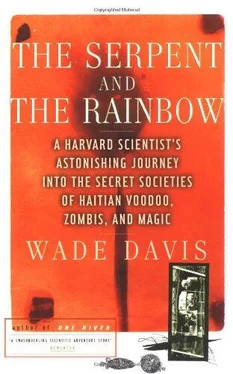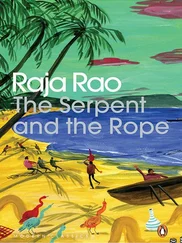Wade Davis - The Serpent and the Rainbow
Здесь есть возможность читать онлайн «Wade Davis - The Serpent and the Rainbow» весь текст электронной книги совершенно бесплатно (целиком полную версию без сокращений). В некоторых случаях можно слушать аудио, скачать через торрент в формате fb2 и присутствует краткое содержание. Год выпуска: 1985, Издательство: Simon & Schuster, Жанр: Старинная литература, на английском языке. Описание произведения, (предисловие) а так же отзывы посетителей доступны на портале библиотеки ЛибКат.
- Название:The Serpent and the Rainbow
- Автор:
- Издательство:Simon & Schuster
- Жанр:
- Год:1985
- ISBN:нет данных
- Рейтинг книги:5 / 5. Голосов: 1
-
Избранное:Добавить в избранное
- Отзывы:
-
Ваша оценка:
- 100
- 1
- 2
- 3
- 4
- 5
The Serpent and the Rainbow: краткое содержание, описание и аннотация
Предлагаем к чтению аннотацию, описание, краткое содержание или предисловие (зависит от того, что написал сам автор книги «The Serpent and the Rainbow»). Если вы не нашли необходимую информацию о книге — напишите в комментариях, мы постараемся отыскать её.
The Serpent and the Rainbow — читать онлайн бесплатно полную книгу (весь текст) целиком
Ниже представлен текст книги, разбитый по страницам. Система сохранения места последней прочитанной страницы, позволяет с удобством читать онлайн бесплатно книгу «The Serpent and the Rainbow», без необходимости каждый раз заново искать на чём Вы остановились. Поставьте закладку, и сможете в любой момент перейти на страницу, на которой закончили чтение.
Интервал:
Закладка:
But there was another type of Maroon, men like Macandal who were not content to hover in the shadows like animals, or waste away in the limestone sinkholes and caves that dotted the land. These were Africans who would take responsibility for their fate, men who sought not just to survive but to fight and to seek revenge for the weight of injustice that had tormented their people. When these men and women left the plantations, taking with them anything of value they had managed to pilfer—a mule, knife, machete, field tools, clothing—they joined the organized bands in remote sanctuaries deep in the hinterland. There they lived in armed camps, sealed off by palisades surrounded by wide ditches, fortified at the bottom by pointed stakes. They cleared gardens, and to a great extent were self-sufficient, supplementing what they grew with periodic raids on the plantations. If solitary runaways were a mere irritation to the French, these independent Maroon retreats were no less than training grounds for guerrilla fighters that threatened the order and stability of the entire colony.
The French regime responded by waging an incessant campaign of extermination. Specialized military forces known as marcehaussée were maintained and sent on frequent and costly forays into the mountains. Some of these expeditions were moderately successful, returning with captives who were publicly broken on the wheel. Others never came back at all. And not one was able to penetrate or destroy the principal strongholds. For the French could not be everywhere, and the Maroons were—in the mountains rising behind the plantations of the northern plain at Cap Francis, the Cul-de-Sac near Port-au-Prince or the rolling valleys near Cayes in the south. As a result, by the mid-eighteenth century entire regions were effectively sealed off to whites. One rebellion that covered a vast mountain block in the south lasted a hundred years, until the French finally abandoned the zone altogether. Further north a Maroon community in the Bahoruco Mountains thrived for eighty-five years, until the French proposed a truce under the terms of which the Maroons would be permitted to form an independent clan. When the leader of that particular band of rebels arrived to negotiate, it was discovered that he had been a Maroon for over forty-five years.
As the French military expeditions collapsed in the mountains, the colonial administration did what it could to destroy the clandestine network that maintained the flow of goods and information between the plantations and the Maroons. Fear of the rebels was behind the constant legislation restricting the movement and normal interaction between the slaves. Blacks were prohibited from going out at night, visiting neighboring plantations, using boats, or even talking among themselves without the master’s permission. Night searches were frequent, and anyone caught with weapons or aiding runaways was brutally and publicly punished. But at a time when slaves outnumbered whites a hundred to one on the plantations, there was really very little the French could do. For even if some of the slaves came to fear the wrath and disruption of the Maroons as much as they did the whip of the planters, there could be no doubt that the rebel bands fought for freedom, and as a result with each successive generation their legend grew. With increasing impunity, the guerrillas came out of the hills, raiding stores, pillaging plantations, and all the while spreading along with terror the idea of liberty. By 1770, according to a contemporary report, the number of Maroons had increased to such proportions that “security became nonexistent” and it was unwise to wander alone in the hills.
Just who and how many chose to follow this desperate path is uncertain, but colonial records provide some clues. Between the years 1764 and 1793, for example, newspaper advertisements alone indicate some forty-eight thousand cases of Maroonage. How many of these ended up in the Maroon enclaves is not known, but the figure does provide a sense of the scale of the problem that faced the French. Significantly, a large percentage of those who did flee had not lived in the colony more than a year, and many escaped virtually off the docks. One colonial document covering a single port for a fifteen-day period in January of 1786 lists 43 new slaves escaped or recaptured. In 1788, out of 10,573 slaves disembarked over a ten-month period at Cap Francis, more than 2,000 got away. Critically, while the Creole Maroon could slip inconspicuously into the bowels of the city, these fresh arrivals from Africa, ignorant of the ways of the colony, were the ones invariably to flee to the hills. Thus a good many of the recruits to the Maroon communities were the individuals least socialized into the regime of the whites. Into their new homes, then, they brought not the burdens of slavery but the ways of Africa.
Behind a veil of secrecy that alone allowed them to survive, these Maroon communities developed genuine political, economic, and religious systems of their own. Their leaders were culled from what contemporary observers described as a “new class of slave” that arrived in the colony throughout the eighteenth century. These were men of royal blood, often educated not just by their own oral traditions but by Arab teachers, and endowed by birth with intelligence, moral vigor, and the call of a militant tradition. Their people were also a chosen lot, mostly young men between the ages of seventeen and thirty-five, each one the end product of a tortuous selective process. Merely to reach the Maroon camps implied surviving the brutal passage from Africa, enduring the abuse on the plantations, and then outwitting the hounds of the bounty hunters to face willingly a life of daily risk, physical deprivation, and constant adversity.
Acceptance into the ranks of the Maroons was strictly controlled. Only those who came voluntarily were taken, and these only after making sure that they were not colonial spies. Blacks captured during raids could be made slaves, and on the slightest suggestion of betrayal were put to death. Newly arrived runaways had first to erase their past, mutilating their brands with knives or the juice of toxic plants— acajou or bresillet—that caused disfiguring welts. They endured rigorous initiations in which they learned the secret handshakes and pass words that would distinguish friend from foe during the raids. Publicly they swore allegiance to the community, and discovered in graphic terms what would occur should they betray the secrets of the group. If secrecy defined and protected the integrity of these communities, the obvious models for their internal organization were the secret societies that at least some of the ex-slaves must have joined in their youth in Africa.
As they are today, during the colonial era secret societies were a dominant social force throughout much of West Africa, particularly among the coastal rain forest peoples who were taken in bondage to Saint Domingue. The parallels between these groups and what later evolved in the Maroon communities in the colony are striking. Membership was by initiation, a lengthy process that exposed the candidate to physical hardships, tests of endurance and pain, following which he learned the secret passwords, symbols, and handshakes of the society. As in Saint Domingue, it was knowledge of these esoteric signs that defined the group; in virtually every other regard the societies were not secret, and in fact their function demanded that their existence be completely known. For these societies were no mere peripheral feature of West African culture; they lay at the very core and remained, both before and after the colonial era, the principal and militant champion of the traditional way of life. The Poro society of Sierra Leone, for example, left its mark on virtually every facet of Mende life, taking responsibility for tribal education, the regulation of sexual conduct, the supervision of political and economic affairs, as well as the operation of social services including recreation and medical care. A key to the strength of the West African secret societies—and what was particularly applicable to the needs of the Maroons—was the fact that their interests and activities were defined in terms of the community, rather than a lineage or clan. Thus they provided for the Maroon bands an invaluable model for the consolidation of the diverse cultural backgrounds of the individual slaves.
Читать дальшеИнтервал:
Закладка:
Похожие книги на «The Serpent and the Rainbow»
Представляем Вашему вниманию похожие книги на «The Serpent and the Rainbow» списком для выбора. Мы отобрали схожую по названию и смыслу литературу в надежде предоставить читателям больше вариантов отыскать новые, интересные, ещё непрочитанные произведения.
Обсуждение, отзывы о книге «The Serpent and the Rainbow» и просто собственные мнения читателей. Оставьте ваши комментарии, напишите, что Вы думаете о произведении, его смысле или главных героях. Укажите что конкретно понравилось, а что нет, и почему Вы так считаете.












